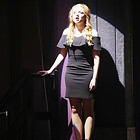DANCE CLASSES IN DEVON
If you're looking for fun, energetic dance and performance classes in Devon, Alison Axford Theatre School is the place to be! We offer a broad range of performing arts classes for children from as young as 2 years old up to adults.
Non-Major Classes
1 class per wk
2 classes per wk
3 classes per wk
4 classes per wk
5 classes per wk
6 classes per wk
(GRADES only)
£20 monthly
£35 monthly
£45 monthly
£52.50 monthly
£57.50 monthly
£65 monthly
Major Classes
1 class per wk
2 classes per wk
3 classes per wk
4 classes per wk
(Inter F +)
£25 monthly
£50 monthly
£75 monthly
£100 monthly
Tip Tap Toe - triple genre bubbles
2-3yrs (1hr) Ballet, Song, Tap
3-5yrs (1¼hrs) Ballet, Modern, Tap
(2-5 yrs)
£22.50 monthly
£27.50 monthly
The Alison Axford Scholar Scheme
This is a scheme devised to enhance your child’s training, gaining experience in numerous genres without the associated cost of many different classes. There are 3 types of 'Scholar' scheme available:
Please contact us prior to booking any classes to enrol on one of our Scholar Schemes.
Classes & Genres on offer



Classical Ballet is the backbone of all dance genres. Working on developing the core stability and poise needed for this difficult style is tackled with the use of both the ISTD and RAD examination syllabi which are highly recognised in all vocational schools should your child wish to further their training at 16 years of age. Established in 1904 the Imperial Society of Teachers of Dancing (ISTD) is one of the world's oldest and most influential dance examination boards. Their training is diverse and they offer a wide spectrum of vocational, recreational and social dance exams to children and students. The Royal Academy of Dance method is a ballet technique and training system that was founded by a diverse group of ballet dancers. They merged their respective dance methods (Italian, French, Danish and Russian) to create a new style of ballet that is unique to the organisation and is recognised internationally as the English style of ballet.
Modern & Jazz dance develops the dancer’s core body strength, and is a very physical, athletic style of dance whilst lyrical challenges the dancer to express the emotions of the lyrics and interpret the music through their movements. The ISTD (Imperial Society of Teachers of Dance) again recognised internationally, has an extensive and extremely successful selection of syllabi to enhance the pupils training and development.
Tap dance is a form of dance characterised by using the sounds of tap shoes striking the floor as a form of percussion. Two major variations on tap dance exist: rhythm (jazz) tap and Broadway tap. Broadway tap focuses on dance; it is widely performed in musical theatre. Rhythm tap focuses on musicality and close to the floor footwork improving speed tapping. The ISTD have incorporated all of this into their tap syllabus extensively looking after the tap dancers development.

Tip Tap Toe Our new “Tip Tap Toe” classes for children aged between 2-7 years are a triple bubble class of Ballet, Tap and then Song or Modern Dance. These classes take place at the studios on the same day, within the same session, offering our youngest performers the chance to experience and express through these different genres of dance, broken down into bite sized chunks. These classes will run as Ballet followed by Modern or Song and then Tap to finish - three classes in one visit for one price!


Musical theatre is a form of theatrical performance that combines songs, acting, and dance. We will work on singing techniques and how to warm up and sing in groups as well as pairs and solos as appropriate. Our classes involve song and performance, working on projection and confidence along with suitable choreography to make the song into a performance.
Contemporary dance has grown to become one of the dominating performance genres for formally trained dancers throughout the world. It has come to incorporate elements from many styles of dance, but closely related to modern dance, ballet and other classical concert dance styles. Contemporary dance tends to utilise both the strong and controlled legwork of ballet together with the modern dancer's core stability. It also employs contract and release, floor work, fall and recovery, and improvisation characteristics of modern dance.

Acrobatics is the performance of extraordinary feats of balance, agility, and motor coordination. It can be found in many of the performing arts as well as in many sporting events, and martial arts. Acrobatics is most often associated with activities that make extensive use of gymnastic elements. We work on flexibility, developing useful 'tricks' that can be utilised within performances and also develop double/team work.

Street/Commercial is a funky dance style which utilises many of the dynamics found in music videos today. Street dance evolved outside dance studios in any available open space such as streets, dance parties, block parties, parks, and nightclubs. Dances are often improvisational and social in nature, encouraging interaction and contact with spectators and other dancers.

Body conditioning Even the best sense of rhythm, the most careful technical training, and the most astute dance intuition aren’t enough to make a dancer truly excel; you also need focused strength, balance, and flexibility to execute the movements with power and grace. Body Conditioning improves your technique and performance in all dance forms by strengthening the body’s core (abdominal and back muscles) while improving coordination, balance, and alignment and optimising flexibility. The result is more lift without tension, deeper pliés, higher jumps with less effort, tighter turns, and improved extension and turnout.



